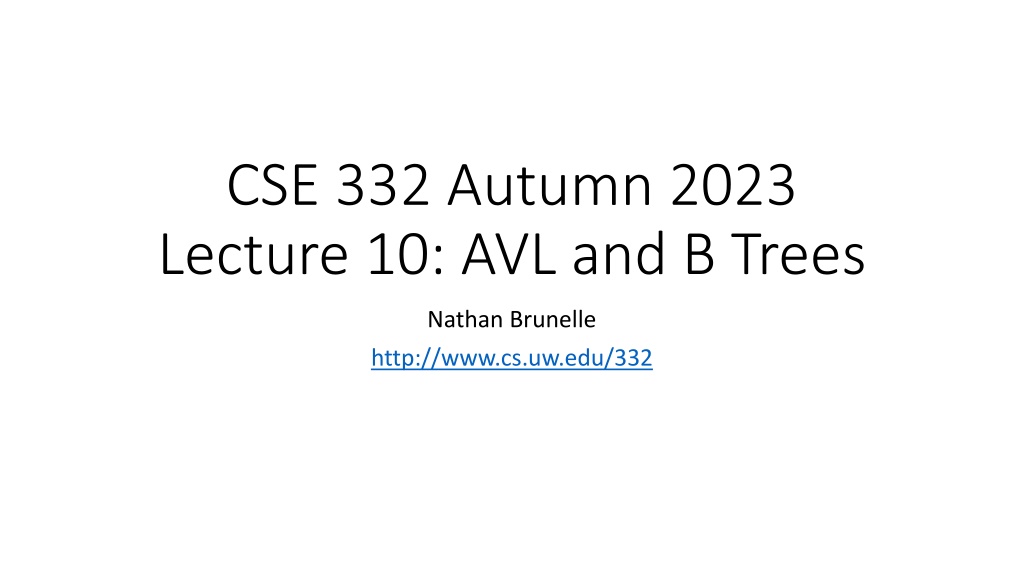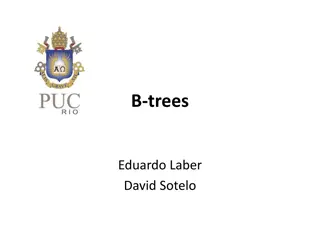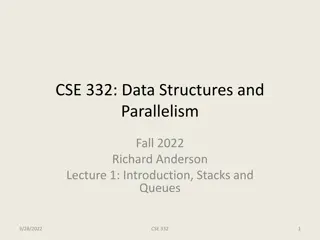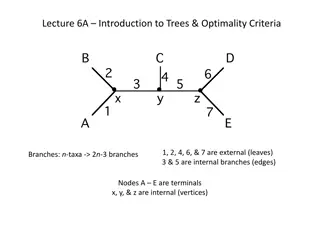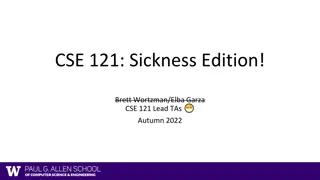Understanding AVL and B-Trees in CSE 332 Autumn 2023
AVL trees are self-balancing binary search trees that ensure the heights of left and right subtrees differ by at most one, maintaining balance during insertions and deletions through rotations. This lecture delves into AVL trees, their implementation, balancing techniques, and examples, along with insights on B-Trees.
Download Presentation

Please find below an Image/Link to download the presentation.
The content on the website is provided AS IS for your information and personal use only. It may not be sold, licensed, or shared on other websites without obtaining consent from the author. Download presentation by click this link. If you encounter any issues during the download, it is possible that the publisher has removed the file from their server.
E N D
Presentation Transcript
CSE 332 Autumn 2023 Lecture 10: AVL and B Trees Nathan Brunelle http://www.cs.uw.edu/332
AVL Tree A Binary Search tree that maintains that the left and right subtrees of every node have heights that differ by at most one. height of left subtree and height of right subtree off by at most 1 Not too weak (ensures trees are short) Not too strong (works for any number of nodes) Idea of AVL Tree: When you insert/delete nodes, if tree is out of balance then modify the tree Modification = rotation
Using AVL Trees Key = 9 Each node has: Key Value Height Left child Right child Value = hello Height = 3 Left = Node 3 Right = Node 10 9 10 3 6 16 1 5 7 0
Inserting into an AVL Tree Starts out the same way as BST: Find where the new node should go Put it in the right place (it will be a leaf) Next check the balance If the tree is still balanced, you re done! Otherwise we need to do rotations
Insert Example -1 9 10 3 6 16 1 2 7 0
Not Balanced! Solution: rotate the whole tree to the right 9 Height = 3 Height = 1 10 3 6 16 1 2 7 0 -1
Balanced! 3 9 1 10 2 6 0 16 7 -1
Right Rotation Make the left child the new root Make the old root the right child of the new Make the new root s right subtree the old root s left subtree + 3 + 2 ? ? + 2 + 1 + 1 ? ? ? ? Right Rotation + 1 ? ? ? ? ? ?
Insert Example 20 9 11 3 16 6 1 10 2 18 0
Not Balanced! Solution: rotate the deepest imbalance to the left 9 Height = 2 Height = 3 11 3 Height = 2 16 6 1 10 Height = 0 2 18 0 20
Balanced! 9 11 3 18 6 1 10 16 2 20 0
Left Rotation Make the right child the new root Make the old root the left child of the new Make the new root s left subtree the old root s right subtree + 3 + 2 ? ? + 1 + 1 + 1 + 2 ? ? Left ? ? Rotation + 1 ? ? ? ? ? ?
Insertion Story So Far After insertion, update the heights of the node s ancestors Check for imbalance If there s imbalance then at the deepest root of imbalance: If the left subtree was deeper then rotate right If the right subtree was deeper then rotate left This is incomplete! There are some cases where this doesn t work! 9 9 5 Right Rotation 5 9 Insert 7 5 7 7
Insertion Story So Far After insertion, update the heights of the node s ancestors Check for imbalance If there s imbalance then at the deepest root of imbalance: Case LL: If we inserted in the left subtree of the left child then rotate right Case RR: If we inserted in the right subtree of the right child then rotate left Case LR: If we inserted into the right subtree of the left child then ??? Case RL: If we inserted into the left subtree of the right child then ??? Cases LR and RL require 2 rotations!
Case LR From root of the deepest imbalance: Rotate left at the left child Rotate right at the root 9 9 9 Rotate Left at 5 7 Insert 7 Rotate Right at 9 5 5 7 9 5 7 5
Case LR in General Imbalance caused by inserting in the left child s right subtree Rotate left at the left child Rotate right at the imbalanced node + 3 + 3 + 2 ? ? ? + 2 Rotate Right at ? + 2 + 1 Rotate Left at ? ? + 1 ? ? ? + 1 ? ? + 1 ? ? ? ? ? ? ? ? ? ? ? ? ? ? ? ? ? ?
Case RL in General Imbalance caused by inserting in the right child s left subtree Rotate right at the right child Rotate left at the imbalanced node + 3 + 2 ? ? + 3 ? Rotate Right at ? Rotate Left at ? + 1 + 2 ? + 2 ? + 1 ? ? + 1 ? + 1 ? ? ? ? ? ? ? ? ? ? ? ? ? ? ? ? ? ? ?
Insert Summary After a BST insertion, update the heights of the node s ancestors Check for imbalance If there s imbalance then at the deepest root of imbalance: Case LL: If we inserted in the left subtree of the left child then: rotate right Case RR: If we inserted in the right subtree of the right child then: rotate left Case LR: If we inserted into the right subtree of the left child then: rotate left at the left child and then rotate right at the root Case RL: If we inserted into the left subtree of the right child then: rotate right at the right child and then rotate left at the root
Large memory is slow to access. We use different layers or memory to balance quantity of storage with speed of access. Ideally the data we want is in small memory, but we may need to go deep Memory Hierarchy Size: 1 KB Speed: Free CPU Size: 128 KB Speed: 2 cycles per lookup L1 Cache Size: 2 MB Speed: 30 cycles per lookup L2 Cache Size: 2 GB Speed: 250 cycles per lookup Main Memory Size: 1 TB Speed: 8,000,000 cycles per lookup Disk
B Trees Motivation Memory Locality Observation: in practice, when you read from memory you re likely to soon thereafter read from nearby memory When memory is fetched , it s collected in blocks at a time Works well for arrays (they re contiguous is memory) May not be helpful for linked lists, BSTs, etc. (pointers could go wherever) Solution: Have a BST-like data structure which can take advantage of locality
First Idea BST nodes have a lot of information inside them We don t need that information for intermediate nodes Solution: Delay loading anything except keys as long as possible Key = 9 Value = hello Left = Node 3 Right = Node 10 9 10 3 6 16 1 5 7 0
Second Idea Nodes may not be close to each other in memory In the worst case, each step in a traversal could go deep in memory Solution: Increase branching factor of tree load blocks of keys at a time M-ary tree: each node has at most M children Choose M to snugly fit in a block
13 38 B Trees (aka B+ Trees) 3 5 9 55 20 25 Two types of nodes: Internal Nodes Sorted array of ? 1 keys Has ? children No other data! Leaf Nodes Sorted array of ? key-value pairs Subtree between values ? and ? must contain only keys that are ? and < ? If ? is missing use If ? is missing use 1 3 5 9 13 20 25 38 55 2 4 6 10 14 24 27 40 90 7 17 30 50 ? ? ? ? < ?
Find Start at the root node Binary search to identify correct subtree Repeat until you reach a leaf node Binary search the leaf to get the value 13 38 3 5 9 55 20 25 1 3 5 9 13 20 25 38 55 2 4 6 10 14 24 27 40 90 7 17 30 50
B Tree Structure Requirements Root: If the tree has ? items then root is a leaf node Otherwise it is an internal node Internal Nodes: Must have at least 2 children (at least have full) Leaf Nodes: Must have at least Must have at least All leaves are at the same depth ? ? 2 items (at least have full)
Insertion Summary Binary search to find which leaf should contain the new item If there s room, add it to the leaf array (maintaining sorted order) If there s not room, split Make a new leaf node, move the larger half of the items to it If there s room in the parent internal node, add new leaf to it (with new key bound value) If there s not room in the parent internal node, split that! Make a new internal node and have it point to the half the leaves (with correct key bound values) If there s room in the parent internal node, add this internal node to it If there s not room, repeat this process until there is!
Insertion TLDR Find where the item goes by repeated binary search If there s room, just add it If there s not room, split things until there is
Insert Example Insert 22 13 38 3 5 9 55 20 25 1 3 5 9 13 20 25 38 55 2 4 6 10 14 24 27 40 90 7 17 30 50
Insert Example Insert 22 13 38 3 5 9 55 20 25 1 3 5 9 13 20 25 38 55 2 4 6 10 14 22 27 40 90 7 17 24 30 50
Insert Example Insert 26 13 38 3 5 9 55 20 25 1 3 5 9 13 20 25 38 55 2 4 6 10 14 24 27 40 90 7 17 30 50
Insert Example Insert 26 13 38 3 5 9 55 20 25 27 1 3 5 9 13 20 25 38 55 27 2 4 6 10 14 24 26 40 90 30 7 17 50
Insert Example Insert 8 13 38 3 5 9 55 20 25 1 3 5 9 13 20 25 38 55 2 4 6 10 14 24 27 40 90 7 17 30 50
Insert Example 5 5 7 Insert 8 Split! 6 6 8 7 8 3 5 9 9 3 5 Split! 1 3 5 9 7 7 9 5 1 3 2 4 6 10 8 8 10 6 2 4
Insert Example 13 38 Insert 8 55 20 25 9 3 5 13 20 25 38 55 14 24 27 40 90 7 9 5 1 3 17 30 50 8 10 6 2 4
Insert Example Insert 8 7 13 38 55 20 25 9 3 5 13 20 25 38 55 7 9 5 1 3 14 24 27 40 90 8 10 6 2 4 17 30 50
